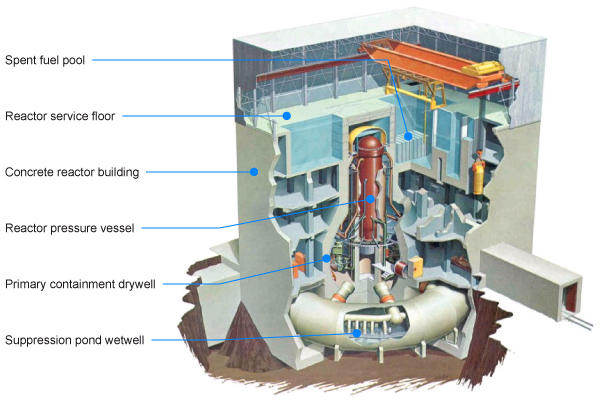
Following a massive earthquake and tsunami off the northeastern coast of Japan on March 11, 2011, three nuclear reactors were severely damaged in the Fukushima Daiichi nuclear reactor. The overflow of water in the nuclear power plant caused the power from the grid and majority of the back up generators to be cut off which subsequently caused the power to be shut off from the heat exchanges that disposed of the reactor heat waste and nuclear waste into the sea. The main problem was that three units lost power and lost the control of their reactor cooling and water circulation functions, ultimately causing the meltdown of the units.
Although the reactors had shut down in response to the earth quake warnings, they were still extremely hot due to the reactions being done before they had been shut down. The back up diesel generators had kicked in and initially began the cool down process; however, once the first waves of the tsunami hit, those generators were flooded and lost their power. Because the tsunami had caused the most damage to the roads and maintenance routes in and around the power plant, there was no quick or easy way into the heart of the problem to fix it.
With the melting of the three units, the temperatures inside were very high and hydrogen was being created and released into the air. This all led to multiple explosions and radioactive shrapnel and debris to be emitted into the air. Along with the radioactive emissions, there was quite a bit of radioactive waste being leaked into the sea, contaminating the water.

Although the earth quake and tsunami took the lives of around 20,000 people, this nuclear disaster did not cause any severe effects to the people on the ground in the area as they were all evacuated immediately. A lot of the area around the power plant was quarantined off to the public for nearly a year following the accident to ensure everyone’s safety. Some specific areas remain quarantined to this day. While much of the radioactive material in the sea has been controlled and reduced, there is still a large number of animals that show signs of contamination. The Japanese government’s swift and effective observation of the incident and the areas affected proved to save many lives and keep the public safe from consuming radioactive run off from the disaster.
In the past few years following the Fukushima Daiici disaster, Japan has been reflecting on how they will be producing energy in the future. They have been coming up with new strategies in order to increase efficiency in energy production while decreasing the risk for another disaster and other nuclear problems. With these new strategies, Japan is going to continue to rely heavily on nuclear power, while implementing other renewable sources, such as wind and solar, more.
http://www.world-nuclear.org/info/safety-and-security/safety-of-plants/fukushima-accident/
https://upload.wikimedia.org/wikipedia/commons/b/b0/Towns_evacuated_around_Fukushima_on_April_11th,_2011.png